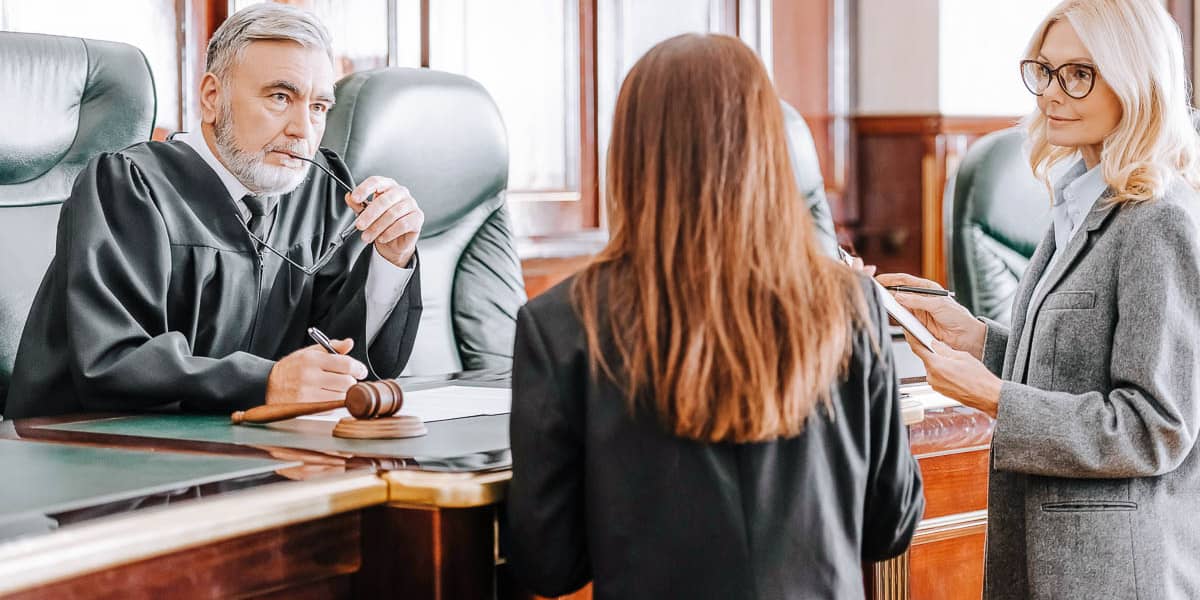Dos and Don’ts for What to Wear in Court

- Dressing for court
- Understanding the stakes: Why your attire matters
- Do follow these general style rules
- Dos for everyone, regardless of gender
- Don’ts: Inappropriate court attire
- Some more don'ts
- What if I can’t afford to dress for court?
- Courtroom expectations and navigating bias
Understanding the significance of attire in a courtroom setting is essential. It not only influences others’ perception of you, but it can also boost your confidence. Your choice of clothing can subtly communicate respect for the legal process.
In this article, we shed light on this often-overlooked aspect of court proceedings, particularly in the context of divorce cases. We provide actionable, precise advice on what to wear to court, helping you navigate this complex process with ease.
Dressing for court
The attire you choose to wear to court plays a pivotal role in the proceedings. It's not merely about making a good impression; it’s also about conveying respect for the legal institution and its procedures. Conservative, clean, and professional attire is paramount in this regard. It subtly communicates your seriousness and readiness to engage with the process.
Here's a quick checklist to guide you:
- Solid colors: Opt for solid colors over patterns or prints. They are less distracting and project a sense of reliability and professionalism.
- Formal shoes: Footwear matters. Choose formal shoes that are clean and polished. Avoid casual options like sneakers or sandals.
- Minimal jewelry: Keep jewelry to a minimum. Excessive or flashy accessories can be distracting and may portray an image of frivolity.
- Neat grooming: Personal grooming should not be overlooked. Neatly styled hair, trimmed nails, and subtle makeup (if applicable) are essential.
Another way of saying all of this could be: Dress in clothing that makes you feel good about your case.
You need to look polished yet comfortable. For some, that means business attire. For others, it's more casual. You don't have to spend a lot of money on new clothes, but if it makes a difference in how you look and feel, spending a bit on the perfect outfit could pay off.
Your attire in court is more than just a personal style statement; it's a reflection of your respect for court decorum and can significantly impact how your case is perceived.
Understanding the stakes: Why your attire matters
When you enter a courtroom, you're stepping into an environment steeped in tradition and formality. A conservative, professional appearance aligns with this atmosphere. Conversely, casual or inappropriate attire can disrupt this decorum, potentially leading to negative perceptions.
But it doesn't end there. Your attire can also influence perceptions of your character and reliability. Remember, every detail in a courtroom, from your body language to your clothing choice, can be scrutinized. By dressing appropriately, you give no room for unfavorable assumptions.
Here are our dos and don'ts for the next time you get dressed for court. Some of these tips may seem like common sense or a bit too conservative, but it's best not to draw possibly negative attention to your physical appearance. As much as judges try to refrain from bias, first impressions matter, and even subtle physical cues can send strong messages.
Do follow these general style rules
For those who identify as male:
- Shoes with socks
- Long pants (wear a belt if they have belt loops)
- Tucked-in collared shirts
- Pants worn at waist level
For those who identify as female:
- Closed-toe shoes
- Knee-length or longer dress or skirt or long pants
- Blouses, sweaters, or casual dress shirts are the best tops
Dos for everyone, regardless of gender
Do scope out your judge's courtroom before you need to appear
How are others in the courtroom dressed? You may want to dress more conservatively than usual, depending on what others are wearing. Pay attention to the people the judge seems to view most and least positively, and scrutinize whether what they are wearing could be a factor.
Do review your wardrobe at home
Look for what you already own that might be appropriate. What you wear to work, job interviews, important meetings, church, or other more formal settings might be perfect court attire, too.
Do consider why you're appearing in court
If you're seeking spousal support, don't come outfitted in designer duds and expensive accessories. If you're appearing for the first time, err on the side of subdued, conservative attire so you look as neutral as possible. Even judges have biases, and a loud print or revealing cut might penalize you.
Do ask anyone attending court with you to abide by a similar dress code as you
A judge may also form impressions of you by the company you keep.
Do show up well-groomed
Maintaining impeccable grooming standards is essential when appearing in court.
- Hair: Keep your hair neat and clean. For men, a well-trimmed beard or clean-shaven look is recommended. Women should opt for simple hairstyles that aren't overly elaborate or distracting.
- Nails: Clean, trimmed nails are a detail not to be overlooked. They contribute to a polished appearance.
- Scent: Be mindful of your scent. Avoid strong perfumes or colognes, as they can be overpowering in a closed environment like a courtroom.
Every aspect of your presentation matters in the courtroom. Strive for a polished, professional appearance to support your case effectively.
Don’ts: Inappropriate court attire
When it comes to court appearances, certain items and styles of clothing are generally deemed inappropriate and should be avoided. Here's a list of examples:
- Shorts and above-the-knee skirts: These can be viewed as too casual or disrespectful. Instead, opt for trousers or skirts that fall at or below the knee.
- Hats or hair curlers: These accessories can be seen as disrespectful or distracting. Aim for neat, simple hairstyles without these additions.
- Halter, tube, or crop tops: Such tops can be viewed as overly casual or revealing. A blouse or shirt with sleeves is a better choice.
- T-shirts and most sleeveless tops: These can come off as too casual. Choose tops with sleeves, preferably button-down shirts or blouses.
- Revealing, see-through, or sheer clothing: These could be distracting and are generally considered inappropriate. Opt for opaque materials and conservative cuts.
- Clothing that reveals underwear: This includes low-rise pants or skirts and low-cut tops. Make sure your clothing fully covers your underwear.
- Ripped or torn clothing: This can give an impression of carelessness. Wear neatly maintained clothes without visible damage.
- Clothing with words, symbols, or anything else that may be seen as inappropriate or offensive: This can be distracting and could potentially offend someone in the courtroom. Stick to plain, unadorned clothing.
Some more don'ts
Don't dress in clothing that makes you feel uncomfortable or awkward
You want to be your authentic self, so don't pretend to be someone you are not. If you don't like high-heeled shoes, flats are just fine. If suits and ties make you cringe, opt for a nice sweater or button-down shirt instead.
Also, wear clothes that fit. Too-tight or too-baggy clothes are a don't for a courtroom appearance.
Don't forget to wear clean, wrinkle-free clothes
If you show up looking messy, a judge might wonder about your ability to take care of other adult responsibilities, too.
Don't reveal piercings or tattoos
We know! We love you to be you. But you never know if the judge might view them negatively.
Don't pile on accessories
Wear one or two simple accessories at the most.
Don't rush
Allow plenty of time to get dressed and groomed before court. You don't want to change your mind last minute and need to do a total outfit change or get frazzled and sweaty. Ideally, you should have time to relax and mentally prepare.
What if I can’t afford to dress for court?
Don't spend more than you can afford. If you don't have anything appropriate but lack the funds to go shopping, consider asking a friend who is your size to borrow some of their clothes. You may also qualify for programs that can set you up with lightly used clothing, such as Dress for Success. Or, you could go the sustainable route and try a clothing rental service like Armoire or Rent the Runway.
Budget-conscious court attire
Chain thrift stores like Goodwill and Salvation Army offer a variety of professional clothing at affordable prices. These stores often carry gently used suits, blouses, and dress shoes, allowing you to put together a court-appropriate outfit without spending excessively.
Online marketplaces such as eBay, Poshmark, and even Facebook Marketplace can also be a treasure trove for budget-friendly professional attire. You can find a wide range of options, from brand-new items to “pre-loved” pieces in excellent condition.
The goal is to present a professional image that shows respect for the court proceedings. This can be achieved without overspending, through thoughtful, budget-conscious choices.
Courtroom expectations and navigating bias
Courtroom standards tend toward conservative and professional attire. This is not an attempt to suppress individuality. Rather, it is a measure to maintain the solemnity of the proceedings. Your clothing should not distract from the case at hand.
However, it's important to acknowledge that biases exist, even in a court of law. While judges strive for impartiality, perceptions can be influenced by various factors, including appearance.
Understanding the expectations and dressing appropriately is an effective way to ensure your attire does not negatively impact perceptions. Being consistent in your presentation can help establish reliability and credibility. Consistency in your attire sends a message of stability and trustworthiness.
.png)
Have Questions About Divorce?
Related:



